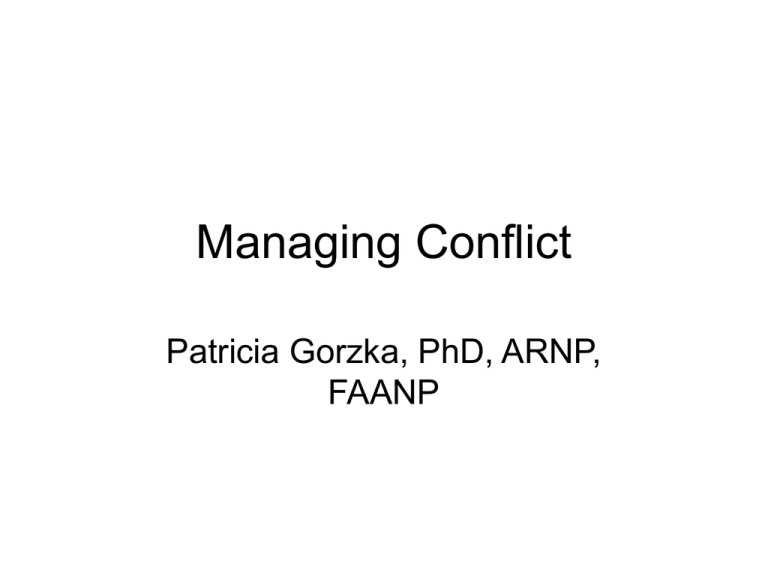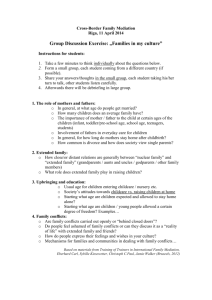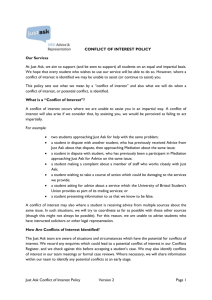Managing Conflict
advertisement

Managing Conflict Patricia Gorzka, PhD, ARNP, FAANP Conflict is normal • 90% average leaders time spent in conflict management • Use conflict to promote good interaction and advance relationships • Problems arise when have fear and avoid conflict Goals of conflict management • Determine root issues/cause-examine for – Root cause analysis • Mutually agree on actions to be taken-fix problem vs. assigning blame. Conflict Management • Encourage appropriate expression of conflict • Consider different perceptions • Identify real source of conflict • Resolve the conflict using values-core values– i.e.-What is best for patient Conflict Management Process Must Address: • Sources of conflict – Environmental-cultural, religion, economics, etc. – Individual-ego, personalilty, perceptions, etc. • Power Sources of Individuals – Level playing field-outcome balanced and fair • Expectations-most frequent cause of conflict Leader Skills • Prevents unnecessary conflict – Open communication to create climate of openness and trust – Ensures congruence of workers goals with organization’s goals – Recognizes sources of conflict and works to facilitate insight Recognize Sources of Conflict • Structure conflicts-unequal powers • Value conflicts-culture, religion, education • Information conflict-different data, assessment, interpretation • Interaction conflicts-communication and language • Interest conflicts-politics and processes Negotion-Individual Interest Conflicts • Be aware of time and place of conflictmove to private place. • Use “I” approaches-parties must own their own feelings • Use visual tools, flip charts, etc., to visually display elements of conflict-this balances language deficits Negotiation-Individuals • Avoid vagueness and ambiguity-leader facilitates clarity • Each party must feel he/she has gained something • Clearly articulate agreement so all parties understand. Negotiation-Team-Based Conflicts • Potential Sources – Unfair or unequitable treatment – Lack of essential information – Game Playing – Not acknowledging everyone’s uniqueness – Lack of mutual respect – Power issues Team-Two Categories of Conflict • Identity-Based Conflict • Interest-based Conflict Identity-Based Conflicts • • • • • Most Difficult Reflect parties culture and beliefs Stems from commitment to values Long duration Can be passed on from one generation to next Sources of Identity-Based Conflicts • • • • • • • • Values Religion Language Heritage Culture Family Community Country Strategies for Facilitator • Give both parties a voice-express perceptions • Use time and patience-move slowly • Build trust-root issue not always apparent – Must have clarity to resolve Strategies (cont.) • Determine what caused the conflict – Ask parties what they want – Recall period before conflict existed-how did they feel? – Do they blame someone and why – What final outcome do they want • May talk with each alone and then together Rothman(1997) ARIA formal resolution process • A-Antagonism-parties express antagonism (expect much blame to be expressed) • R-Resonance-move from antagonism to common ground – Facilitator –safe, open, trusted – Reconceptualize the conflict ARIA (cont.) • I-Invention-focus on identifying solutions – Compromise not desirable-parties see it as giving up – Want new solutions – Develop and agree on objectives • A-Action-set agenda for action-what, who, how, why Interest-Based Conflicts • Leader acts as mediator for negotiations where offers are made and countered • Two kind mediator action – Non contingent-focus on processes for mediation – Contingent-responses to specific circumstances arising from process Interest-Based Conflict-10 Steps to Resolution • Establish initial relationship – Include the parties – Build credibility – Rules of Engagement • Develop strategies to guide process – Assess, collect, and coordinate approaches – Develop plan 10 Steps • Construct the data base – Analyze and verify data – Eliminate inaccurate data – Identify substance of conflict • Organizing the plan for mediation – Develop strategies and techniques – Accommodates contingencies 10 Steps • Building trust and communication – – – – Deal with feelings directly Create safe place Identify and name correct issues Develop effective communication • Beginning the resolution process – Define expectations – Apply approach – Devise structure and flow making sure all parties are heard 10 Steps • Defining concerns and setting priorities – Ensure correct understanding of issues – Agree on issues – Develop strategies to move beyond issues • Looking for the unseen – – – – Discover real issues Find hidden information Name hidden agendas Determine personal agenda 10 Steps • Naming values and options – – – – Moving to agreement Choosing options Naming places of consensus Affirming understanding and choices • Concluding the conflict process – – – – Converging around options Agree to protocol Contract for performance develop action plan Leader-Mediator • Helps parties get “unstuck” – Caucus-work with parties individually – Neutral regarding outcome – Maintains a balance of power – Guide problem solving process – Stay focused on large picture (values) and mutual benefits to be gained Leader-Mediator • Good active listener • Develop meeting schedule and acceptable site • Goodness of fit between mediator and conflicting parties-respect for each other • Facilitate information exchange • May use consultants for resolution






